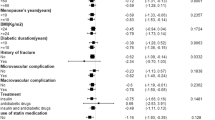Abstract
Purpose
Findings on trabecular bone score (TBS), an index of bone quality, have been reported in prediabetes defined by impaired fasting glucose or HbA1c. Here, we assessed the bone mineral density (BMD) and TBS in prediabetes individuals with impaired glucose tolerance (IGT), and investigated the association of these bone parameters with serum levels of fibroblast growth factor 21 (FGF21), a hormone implicated in bone metabolism and with higher levels in IGT.
Methods
Chinese postmenopausal women aged 55–80 years, without diabetes, were recruited from the Hong Kong Cardiovascular Risk Factor Prevalence Study in 2016–2018. Normal glucose tolerance (NGT) was defined by fasting glucose < 5.6 mmol/L and 2-h plasma glucose (2hG) < 7.8 mmol/L, and IGT by 2hG 7.8–11 mmol/L. Serum levels of FGF21 and other bone metabolism regulators were measured. Insulin sensitivity was assessed by the Matsuda index. Independent determinants of TBS were evaluated using multivariable stepwise linear regression.
Results
173 individuals with NGT and 73 with IGT were included. TBS was lower in those with IGT compared to those with NGT, while BMD was comparable. Individuals with IGT had significantly higher serum FGF21 levels, which in turn showed an independent inverse relationship with TBS, attenuated after inclusion of the Matsuda index. Serum FGF21 levels, however, did not correlate with BMD.
Conclusion
Among Chinese postmenopausal women, bone quality was worse in IGT, despite comparable bone density. FGF21 levels showed a significant independent inverse relationship with TBS, partly attributed to insulin resistance. Whether FGF21 contributes to the impaired bone quality in IGT remains speculative.
Similar content being viewed by others
References
McCloskey EV, Oden A, Harvey NC, Leslie WD, Hans D, Johansson H et al (2015) Adjusting fracture probability by trabecular bone score. Calcif Tissue Int 96(6):500–509
Ho-Pham LT, Nguyen TV (2019) Association between trabecular bone score and type 2 diabetes: a quantitative update of evidence. Osteoporos Int 30(10):2079–2085
Vestergaard P (2007) Discrepancies in bone mineral density and fracture risk in patients with type 1 and type 2 diabetes–a meta-analysis. Osteoporos Int 18(4):427–444
Classification and Diagnosis of Diabetes (2019) Standards of medical care in diabetes-2019. Diabetes Care 42(Suppl 1):S13–28
Law LSC, Tso AWK, Tam S, Wat NMS, Cheung BMY, Lam KSL (2011) Haemoglobin A1c is superior to fasting glucose in predicting the incidence of diabetes over 8 years among Chinese. Diabetes Res Clin Pract 91(2):e53–e56
Meijnikman AS, De Block CEM, Dirinck E, Verrijken A, Mertens I, Corthouts B et al (2017) Not performing an OGTT results in significant underdiagnosis of (pre)diabetes in a high risk adult Caucasian population. Int J Obes (Lond) 41(11):1615–1620
Holloway KL, De Abreu LLF, Hans D, Kotowicz MA, Sajjad MA, Hyde NK et al (2018) Trabecular bone score in men and women with impaired fasting glucose and diabetes. Calcif Tissue Int 102(1):32–40
Ho-Pham LT, Tran B, Do AT, Nguyen TV (2019) Association between pre-diabetes, type 2 diabetes and trabecular bone score: the Vietnam Osteoporosis Study. Diabetes Res Clin Pract 155:107790
Chow WS, Xu A, Woo YC, Tso AWK, Cheung SCW, Fong CHY et al (2013) Serum fibroblast growth factor-21 levels are associated with carotid atherosclerosis independent of established cardiovascular risk factors. Arterioscler Thromb Vasc Biol 33(10):2454–2459
Woo YC, Xu A, Wang Y, Lam KSL (2013) Fibroblast growth factor 21 as an emerging metabolic regulator: clinical perspectives. Clin Endocrinol (Oxf) 78(4):489–496
Chavez AO, Molina-Carrion M, Abdul-Ghani MA, Folli F, Defronzo RA, Tripathy D (2009) Circulating fibroblast growth factor-21 is elevated in impaired glucose tolerance and type 2 diabetes and correlates with muscle and hepatic insulin resistance. Diabetes Care 32(8):1542–1546
Chen C, Cheung BMY, Tso AWK, Wang Y, Law LSC, Ong KL et al (2011) High plasma level of fibroblast growth factor 21 is an Independent predictor of type 2 diabetes: a 5.4-year population-based prospective study in Chinese subjects. Diabetes Care 34(9):2113–2115
Kwok KHM, Lam KSL (2017) Fibroblast growth factor 21 Mimetics for treating atherosclerosis. Endocrinol Metab (Seoul, Korea) 32(2):145–151
Wei W, Dutchak PA, Wang X, Ding X, Wang X, Bookout AL et al (2012) Fibroblast growth factor 21 promotes bone loss by potentiating the effects of peroxisome proliferator-activated receptor gamma. Proc Natl Acad Sci USA 109(8):3143–3148
Wang X, Wei W, Krzeszinski JY, Wang Y, Wan Y (2015) A liver-bone endocrine relay by IGFBP1 promotes osteoclastogenesis and mediates FGF21-induced bone resorption. Cell Metab 22(5):811–824
Lee P, Linderman J, Smith S, Brychta RJ, Perron R, Idelson C et al (2013) Fibroblast growth factor 21 (FGF21) and bone: is there a relationship in humans? Osteoporos Int 24(12):3053–3057
Hu WW, He J, Fu W, Wang C, Yue H, Gu J et al (2018) Fibroblast growth factor 21 is associated with bone mineral density, but not with bone turnover markers and fractures in Chinese postmenopausal women. J Clin Densitom. https://doi.org/10.1016/j.jocd.2018.08.005
Choi HS, Lee HA, Kim SW, Cho EH (2018) Association between serum fibroblast growth factor 21 levels and bone mineral density in postmenopausal women. Endocrinol Metab (Seoul, Korea) 33(2):273–277
Hao R-H, Gao J-L, Li M, Huang W, Zhu D-L, Thynn HN et al (2018) Association between fibroblast growth factor 21 and bone mineral density in adults. Endocrine 59(2):296–303
Janus ED, Watt NM, Lam KS, Cockram CS, Siu ST, Liu LJ et al (2000) The prevalence of diabetes, association with cardiovascular risk factors and implications of diagnostic criteria (ADA 1997 and WHO 1998) in a 1996 community-based population study in Hong Kong Chinese. Hong Kong Cardiovascular Risk Factor Steering Committ. Diabet Med 17(10):741–745
Mei J, Yeung SS, Kung AW (2001) High dietary phytoestrogen intake is associated with higher bone mineral density in postmenopausal but not premenopausal women. J Clin Endocrinol Metab 86(11):5217–5221
Lee CH, Chan RSM, Wan HYL, Woo YC, Cheung CYY, Fong CHY et al (2018) Dietary intake of anti-oxidant vitamins A, C, and E is inversely associated with adverse cardiovascular outcomes in Chinese—a 22-years population-based prospective study. Nutrients 10(11):1664
Woo YC, Lee CH, Fong CHY, Xu A, Tso AWK, Cheung BMY et al (2017) Serum fibroblast growth factor 21 is a superior biomarker to other adipokines in predicting incident diabetes. Clin Endocrinol (Oxf) 86(1):37–43
Lee CH, Hui EYL, Woo YC, Yeung CY, Chow WS, Yuen MMA et al (2015) Circulating fibroblast growth factor 21 levels predict progressive kidney disease in subjects with type 2 diabetes and normoalbuminuria. J Clin Endocrinol Metab 100(4):1368–1375
Matsuda M, DeFronzo RA (1999) Insulin sensitivity indices obtained from oral glucose tolerance testing: comparison with the euglycemic insulin clamp. Diabetes Care 22(9):1462–1470
Leslie WD, Shevroja E, Johansson H, McCloskey EV, Harvey NC, Kanis JA et al (2018) Risk-equivalent T-score adjustment for using lumbar spine trabecular bone score (TBS): the Manitoba BMD registry. Osteoporos Int 29(3):751–758
University of Sheffield UK FRAX_ WHO fracture risk assessment tool 2011. [cited 2020 Feb 6]. Available from: https://www.sheffield.ac.uk/FRAX/tool.aspx?country=20
Monnier L, Colette C (2006) Contributions of fasting and postprandial glucose to hemoglobin A1c. Endocr Pract 12(Suppl 1):42–46
Saito M, Fujii K, Mori Y, Marumo K (2006) Role of collagen enzymatic and glycation induced cross-links as a determinant of bone quality in spontaneously diabetic WBN/Kob rats. Osteoporos Int 17(10):1514–1523
Martineau P, Silva BC, Leslie WD (2017) Utility of trabecular bone score in the evaluation of osteoporosis. Curr Opin Endocrinol Diabetes Obes 24(6):402–410
Iki M, Fujita Y, Kouda K, Yura A, Tachiki T, Tamaki J et al (2017) Hyperglycemia is associated with increased bone mineral density and decreased trabecular bone score in elderly Japanese men: the Fujiwara-kyo osteoporosis risk in men (FORMEN) study. Bone 105:18–25
Kim JH, Choi HJ, Ku EJ, Kim KM, Kim SW, Cho NH et al (2015) Trabecular bone score as an indicator for skeletal deterioration in diabetes. J Clin Endocrinol Metab 100(2):475–482
Li X, Stanislaus S, Asuncion F, Niu Q-T, Chinookoswong N, Villasenor K et al (2017) FGF21 is not a major mediator for bone homeostasis or metabolic actions of PPARα and PPARγ agonists. J Bone Miner Res 32(4):834–845
Fazeli PK, Faje AT, Cross EJ, Lee H, Rosen CJ, Bouxsein ML et al (2015) Serum FGF-21 levels are associated with worsened radial trabecular bone microarchitecture and decreased radial bone strength in women with anorexia nervosa. Bone 77:6–11
Patel V, Joharapurkar A, Kshirsagar S, Sutariya B, Patel M, Patel H et al (2018) Coagonist of GLP-1 and glucagon receptor ameliorates development of non-alcoholic fatty liver disease. Cardiovasc Hematol Agents Med Chem 16(1):35–43
Kim T, Nason S, Holleman C, Pepin M, Wilson L, Berryhill TF et al (2018) Glucagon receptor signaling regulates energy metabolism via hepatic farnesoid X receptor and fibroblast growth factor 21. Diabetes 67(9):1773–1782
Ritchie M, Hanouneh IA, Noureddin M, Rolph T, Alkhouri N (2020) Fibroblast growth factor (FGF)-21 based therapies: a magic bullet for nonalcoholic fatty liver disease (NAFLD)? Expert Opin Investig Drugs 29(2):197–204
Sanyal A, Charles ED, Neuschwander-Tetri BA, Loomba R, Harrison SA, Abdelmalek MF et al (2019) Pegbelfermin (BMS-986036), a PEGylated fibroblast growth factor 21 analogue, in patients with non-alcoholic steatohepatitis: a randomised, double-blind, placebo-controlled, phase 2a trial. Lancet (London, England) 392(10165):2705–2717
Silva BC, Boutroy S, Zhang C, McMahon DJ, Zhou B, Wang J et al (2013) Trabecular bone score (TBS)–a novel method to evaluate bone microarchitectural texture in patients with primary hyperparathyroidism. J Clin Endocrinol Metab 98(5):1963–1970
Acknowledgements
We would like to acknowledge Queen Mary Hospital Charitable Trust for Training and Research Assistance Scheme, which supported the funding for the 25-hydroxyvitamin D and fibroblast growth factor 21 assays, and the Ng Teng Fong Charitable Foundation for supporting the latest CRISPS assessment.
Author information
Authors and Affiliations
Contributions
DTWL researched the data and wrote the manuscript. CHL, JKYL and ACHL researched the data. VWKC, CHYF and KMYY performed statistical analyses. WSC, KCBT, YCW and KSLL critically reviewed and edited the manuscript. YCW and KSLL initiated and supervised the study, are the guarantors of this work and as such had full access to all the data in the study and take responsibility for the integrity of the data and the accuracy of the data analysis. All authors read and approved the final manuscript.
Corresponding authors
Ethics declarations
Conflict of interest
All authors declare that they have no competing interest.
Research involving human participants and/or animals
The study followed the principles in the Declaration of Helsinki and was approved by the Institutional Review Board of the University of Hong Kong/Hospital Authority Hong Kong West Cluster (IRB Ref.: UW 16–510).
Informed consent
All participants gave informed consent.
Additional information
Publisher's Note
Springer Nature remains neutral with regard to jurisdictional claims in published maps and institutional affiliations.
Rights and permissions
About this article
Cite this article
Lui, D.T.W., Lee, C.H., Chau, V.W.K. et al. Potential role of fibroblast growth factor 21 in the deterioration of bone quality in impaired glucose tolerance. J Endocrinol Invest 44, 523–530 (2021). https://doi.org/10.1007/s40618-020-01337-y
Received:
Accepted:
Published:
Issue Date:
DOI: https://doi.org/10.1007/s40618-020-01337-y




